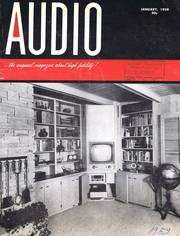Erläuterungen zu diesen US-AUDIO Seiten der 1950er Jahre
Die hier stehenden amerikanischen Artikel aus 1959 (aus der US-AUDIO) sind teilweise sehr gewöhnungsbedürftig, weil sie erstens aus einer längst vergangenen Zeit stammen und zweitens, weil dort in den USA ganz "anders" gedacht wurde als bei uns in Old Germany oder in Europa.
Vergleichbar mit unseren deutschen Hifi-Magazinen etwa ab 1962 ist jedoch, daß auch dieses Audio-Magazin ihre Anzeigen- Kunden und -Leser am Markt oder von anderen Magazinen (be- oder ab- ?) werben mußte. - Weiterhin sind die riesigen Dimensionen des amerikanischen Kontinents mit unseren hier in Europa nicht vergleichbar. - Ein Redaktions-"Trip" von New York nach Los Angeles oder Chicago oder gar in die Wüste nach Las-Vegas zu einer der CES- Audio- "Shows" war - auch mit dem Flugzeug - immer noch eine halbe Weltreise. Und jede Ausstellung oder "Messe" wurde als "Show" deklariert. Und natürlich, in USA musste alles "Show" sein, um beim Publikum einige Aufmerksamkeit zu erzeugen.
.
Die monatliche Kolumne - Editors' REVIEW - das Editorial
"WHAT IS STEREO ?"
Just for the record - and no pun intended - we are belatedly offering the official definition of a true stereophonic record, as adopted by the Board of Directors of the "Record Industry Association of America", Inc. last Fall.
By this action, the RIAA establishes another standard with the definition: "A true stereophonic disc record has two distinct orthagonal modulations derived from an original live recording in which a minimum of two separate channels were employed."
Possibly this will serve to limit spurious, imitation, or pseudo-stereo recordings from being labeled "stereophonic."
Now "stereophonic"
The Magnetic Recording Industry Association similarly approved a definition of the term "stereophonic'? in the following words:
"Stereophonic, stereo, (binaural deprecated) : A technique of transmitting sound which employs two or more complete transmission channels for the purpose of creating in the listening environment the sense of auditory perspective inherent in the source environment. Each channel must include a separate microphone, amplifier, and loudspeaker, and may have one channel of a multichannel recorder and reproducer interposed as a time-storage device".
It is expected that this definition will be of great use to Better Business Bureaus and others who will thus have a standardized yardstick which they may apply in evaluating fraudulent advertising.
Mehr Optimismus bei den Herstellern
Judging from some of the exuberant advertising in the daily and Sunday newspapers, it would seem that these definitions should be reread every morning by those in charge of accepting the ad copy.
Manufacturer are - excusably - more optimistic about their products than a presumably hard-boiled newspaper advertising manager, but there are times when the claims made appear to exceed normal advertising license, expecially when these claims are compared directly with the specifications. Sometimes, caveat emptor.
STEREO BROADCAST PROPOSALS
To date there is no news from the FCC regarding the acceptance of any of the proposed methods for stereo broadcasting, and possibly the delay is a good thing. We still believe that in the interest of conserving the frequency spectrum some form of multiplexing should be adopted.
However, since there is already considerable activity in AM-FM stereo - and recently by NBC, TV with FM and AM - a system which is compatible might be adopted. The sum-and-difference method has many advantages, particularly when the means of transmission is multiplex, but it is not compatible with AM and FM systems. Any system that could be compatible with AM and FM transmissions could also be used with FM multiplex systems.
Stereo-Rundfunk auf der "Los Angeles High Fidelity Show"
During the Los Angeles High Fidelity Show, we were privileged to hear a compatible system which was explained to us in terms which we do not yet understand, although we are inclined to believe that it depends for its operation on the same principle as that used by NBC on the Perry Como broadcast a few weeks ago.
This system, to be described in detail in next month's issue, depends upon the "precedence" effect of sounds reaching the ear from different points. It seems that when a sound is heard from one source only a few milliseconds before it is heard from another, the ear accepts the original sound as localizing the source, and completely disregards the succeeding sound which may come from another point.
The right channel is delayed by a small amount and mixed with the left channel at a slightly lower level. The left channel is delayed the same amount and mixed with the right channel, also at a slightly lower level. Heard through two speakers, the normal stereophonic effect is observed; if one is turned off the complete program is heard in the remaining speaker.
The small delay does not seem to affect the over-all sound of the combined programs, and either of the mixed channels appears to be completely satisfactory. With this method, each of the transmitted channels provides all the program material to its listeners - without, of course, the directional or stereo information - while the listener with both channels in operation will hear a normal stereo broadcast.
In the demonstration we heard, the material consisted of a singer specifically in one channel and a band in the other. Without the mixing system, the left channel appeared to be a singer with a band Vay in the background, while the right channel appeared to be a band with the singer 'way in the background. With the system working, and both speakers turned on, we heard a normal stereo program. When the volume of the left speaker was reduced, the singer seemed to walk across the stage to stand with the band. This demonstration was most effective with the particular material used - how it might sound with other types of material we have to guess. It does seem to have considerable promise, however.
CLARIFICATIONS (bezüglich der Produkte und Namen)
In the single-cabinet stereo speaker article in the January issue, we listed all of the speakers used as being "Philips" units - which they are. However, the Philips products are known in the U.S. as "Norelco", and anyone looking for a Philips product might not immediately be cognizant of the "Norelco" name - which is the trade name of North American Philips Company, Inc.
Similarly, we seem to have assumed that the names "Knight" and "Knight-Kit" would immediately bring to mind Allied Radio Corporation, since they have been synonomous for years.
We profiled the Knight stereo tuner in January and followed it with a profile of the Knight-Kit stereo preamplifier kit in March, and in neither case did we mention the name of Allied Radio Corporation, which is where you get the Knight and Knight-Kit products.


